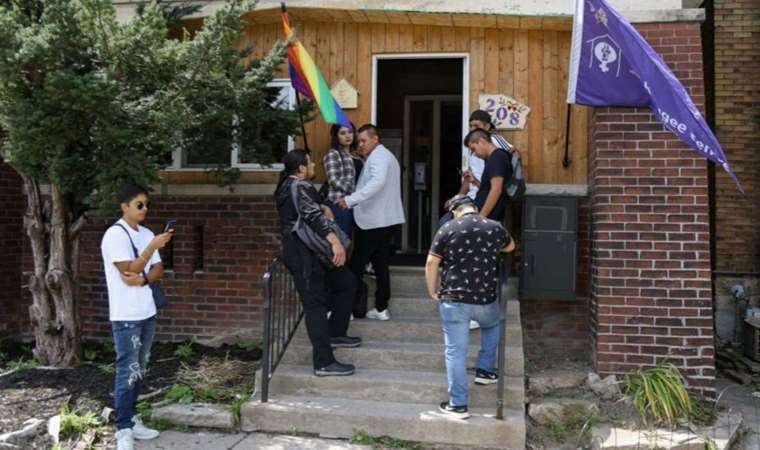Canada closed its land border to asylum seekers, yet more refugees persist
Canada's recent efforts to curtail the influx of asylum seekers from the United States seemed initially successful. In a matter of days, the number of individuals apprehended at unofficial border crossings dropped significantly. However, five months later, the overall number of people seeking refugee status in Canada has increased instead of declining. Many now arrive by air, while others clandestinely cross the border and remain hidden until they can apply for asylum without the fear of being deported, according to individuals assisting migrants, as reported by Reuters.

This situation underscores the challenges faced by countries attempting to restrict entry to desperate individuals and highlights the unexpected problems that a surge in asylum seekers can bring. In Toronto, for instance, hundreds of people slept on the streets this summer while struggling to secure accommodations.
"The fundamental reality is that closing a border does nothing to address the need for protection," emphasized Shauna Labman, an associate professor and acting director of the Human Rights Program at the University of Winnipeg. "It only exacerbates the desperation."
Canada has a reputation for welcoming immigrants and aims to admit a record half a million new permanent residents by 2025 to address a pressing labor shortage. However, it has simultaneously sought to discourage asylum applications, primarily through an agreement with the United States in which both countries return asylum seekers to their originating nation.
Despite these efforts, more than 39,000 asylum seekers entered Canada through unofficial crossings in the previous year, primarily into Quebec via a dirt path off Roxham Road in New York, which prompted the province to express concerns about its capacity to handle these arrivals. Asylum seekers are drawn to Canada due to its reputation for quicker processing and greater acceptance of asylum applications compared to the United States.
In response to this influx, Canada and the United States amended their two-decade-old asylum-seeker pact, known as the Safe Third Country Agreement, in March. This agreement now applies to the entire 4,000-mile land border between the two nations, not just at official ports of entry.
This expansion resulted in a sharp decrease in the number of individuals intercepted at informal crossings, dropping to double digits from 4,173 in March, between April and July.
Nevertheless, the overall number of asylum seekers entering Canada has surged. In July, the total number of refugee claims in Canada reached 12,010, the highest monthly total since at least January 2017, up from 10,120 in March, according to data from the Department of Immigration, Refugees, and Citizenship.
The increased numbers can be attributed, in part, to more people submitting refugee claims at airports or local immigration department offices, often days, weeks, or even months after their arrival in the country, government data indicates.
In July, those applying for asylum at airports accounted for about a third of all refugee claims, compared to roughly 16% in March. Meanwhile, those filing claims at immigration offices made up about 54% of July's total, compared to approximately one-third in March. The top five countries from which claimants arrived in the first half of the year were Mexico, Haiti, Turkey, Colombia, and India. These numbers include individuals who applied before the expanded U.S. pact took effect.
Experts believe that one reason for this recent influx is that Canada is among a diminishing group of countries perceived as offering safe refuge, particularly as the pressures of war, climate change, and human rights violations drive more people to seek asylum.
For instance, the European Union recently introduced an asylum seeker pact allowing member nations to more swiftly return some migrants. The British government is advancing a law that would make it easier to send asylum seekers to Rwanda, while the Biden administration in the United States has implemented regulations making it more difficult for migrants to obtain asylum if they illegally cross U.S. borders.
Craig Damian Smith, a research affiliate at the Centre for Refugee Studies at York University, stated, "If you're an individual faced with these decisions, Canada becomes a more viable option."
Unfortunately, Canada's immigration minister was unavailable for an interview, but Remi Lariviere, a department spokesperson, stated, "The world is facing unprecedented flows of migrants and refugees, and Canada is not immune to these trends." Lariviere noted that Canada amended the agreement with the United States to address "irregular" border crossings, emphasizing that the expansion "does not imply that asylum claims will cease entirely in Canada."
However, individuals assisting migrants suggest that some of those filing claims days or weeks after entering Canada are attempting to circumvent a clause in the expanded U.S. agreement. This clause stipulates that any asylum seeker apprehended within two weeks of crossing the border will be returned, unless they meet specific exemptions. Consequently, some opt to cross unnoticed, occasionally with the assistance of smugglers, and remain hidden until the two-week period expires.
The Refugee Centre in Montreal disclosed that it recently assisted four families who had been in hiding for a fortnight after crossing into the country overland.
Abdulla Daoud, the Executive Director, commented, "Unfortunately this is not a very safe avenue for them. It promotes bad actors who take advantage of these individuals."
At the FCJ Refugee Centre in Toronto, Loly Rico, the Executive Director, estimated that approximately 20% to 30% of recent arrivals claim to have crossed into Canada undetected and stayed with the assistance of smugglers.
Reuters interviewed ten individuals seeking refugee status who recently arrived in Toronto, Canada's largest city. They came from various places, including Sudan, Uganda, and Mexico, and all arrived with valid visas via air travel. Some filed refugee claims days or weeks after their arrival.
While their reasons for leaving ranged from domestic violence to war, the common factor that drew them to Canada was the nation's reputation for protecting human rights and providing refuge.
Hana Bakhit, a 35-year-old from war-torn Sudan, explained, "It is the first country that I thought about." She applied for a visitor's visa in May, flew to Canada in July, and filed a refugee claim two weeks later. She has since been staying in a mosque and a church while calling Toronto's central shelter daily for a bed, but none have been available. Nevertheless, she considers herself fortunate to be in Canada.
With Canada's land border mostly inaccessible, the asylum system now favors individuals like Bakhit who can obtain a visa and plane ticket, according to refugee lawyer Maureen Silcoff. She lamented, "Some of the most vulnerable people remain barred from accessing Canada's system, and I think we have to reflect on the inequity of that development."
Grace Nanziri, 42, was one of the fortunate few able to secure a visa and flight ticket. She applied for a Canadian visitor's visa due to the danger she faced in her home country, Uganda, due to her LGBTQ advocacy. After waiting a year for her visa, she flew to Toronto in August, attracted by Canada's reputation for safeguarding human rights.
"They wanted to kill me," she recounted. "That's why I came to Canada."

En Çok Okunan Haberler
-
 İstanbul'da zincirleme kaza
İstanbul'da zincirleme kaza
-
 En yüksek faizi hangi banka veriyor?
En yüksek faizi hangi banka veriyor?
-
 AKP'de toplu istifa!
AKP'de toplu istifa!
-
 Uçum'dan bu kez '50+1' ayarı
Uçum'dan bu kez '50+1' ayarı
-
 ‘Sinirden kanepe örtülerini dişlemeye başladım’
‘Sinirden kanepe örtülerini dişlemeye başladım’
-
 Barcelona'dan Arda Güler'e büyük övgü!
Barcelona'dan Arda Güler'e büyük övgü!
-
 Yıllar sonra gelen itiraf: 'Onlar varsa oynamam dedim'
Yıllar sonra gelen itiraf: 'Onlar varsa oynamam dedim'
-
 'İnci Taneleri’nde Azem'in kızı Nehir ilk kez göründü
'İnci Taneleri’nde Azem'in kızı Nehir ilk kez göründü
-
 Kuryeden ‘görev tamam’ pozu!
Kuryeden ‘görev tamam’ pozu!
-
 'Milliyet farkı' adı altında fazladan ücret alındı
'Milliyet farkı' adı altında fazladan ücret alındı
















